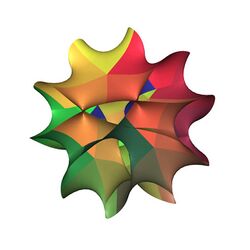Fermat quintic threefold
In mathematics, a Fermat quintic threefold is a special quintic threefold, in other words a degree 5, dimension 3 hypersurface in 4-dimensional complex projective space, given by the equation
- [math]\displaystyle{ V^5+W^5+X^5+Y^5+Z^5=0 }[/math].
This threefold, so named after Pierre de Fermat, is a Calabi–Yau manifold.
The Hodge diamond of a non-singular quintic 3-fold is Script error: No such module "Hodge diamond".
Rational curves
Herbert Clemens (1984) conjectured that the number of rational curves of a given degree on a generic quintic threefold is finite. The Fermat quintic threefold is not generic in this sense, and Alberto Albano and Sheldon Katz (1991) showed that its lines are contained in 50 1-dimensional families of the form
- [math]\displaystyle{ (x : -\zeta x : ay : by : cy) }[/math]
for [math]\displaystyle{ \zeta^5=1 }[/math] and [math]\displaystyle{ a^5+b^5+c^5=0 }[/math]. There are 375 lines in more than one family, of the form
- [math]\displaystyle{ (x : -\zeta x : y :-\eta y :0) }[/math]
for fifth roots of unity [math]\displaystyle{ \zeta }[/math] and [math]\displaystyle{ \eta }[/math].
References
- Albano, Alberto; Katz, Sheldon (1991), "Lines on the Fermat quintic threefold and the infinitesimal generalized Hodge conjecture", Transactions of the American Mathematical Society 324 (1): 353–368, doi:10.2307/2001512, ISSN 0002-9947
- Clemens, Herbert (1984), "Some results about Abel-Jacobi mappings", Topics in transcendental algebraic geometry (Princeton, N.J., 1981/1982), Annals of Mathematics Studies, 106, Princeton University Press, pp. 289–304
- Cox, David A.; Katz, Sheldon (1999), Mirror symmetry and algebraic geometry, Mathematical Surveys and Monographs, 68, Providence, R.I.: American Mathematical Society, ISBN 978-0-8218-1059-0, https://www.ams.org/bookstore-getitem/item=surv-68.s
 |


